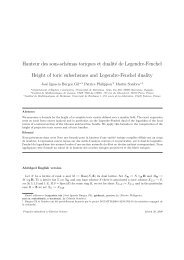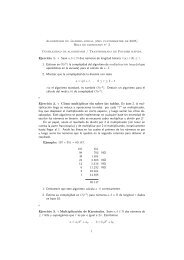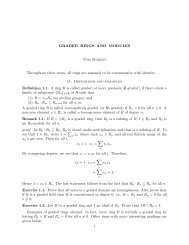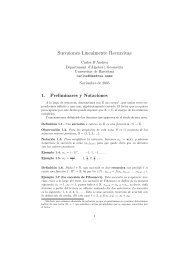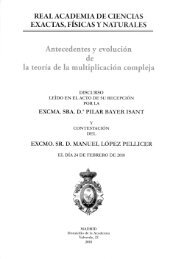Notes - Departament d'Àlgebra i Geometria - Universitat de Barcelona
Notes - Departament d'Àlgebra i Geometria - Universitat de Barcelona
Notes - Departament d'Àlgebra i Geometria - Universitat de Barcelona
You also want an ePaper? Increase the reach of your titles
YUMPU automatically turns print PDFs into web optimized ePapers that Google loves.
Sea N una cota superior para las raíces <strong>de</strong> p(x), y para cada i = 1, 2, 3, Ni una<br />
cota superior para las raíces <strong>de</strong> pi(x).<br />
Teorema 4.7. Con las <strong>de</strong>finiciones y notaciones anteriores, las raíces reales<br />
<strong>de</strong> p(x) (si las hubiere) se encuentran en la unión <strong>de</strong> intervalos disjuntos<br />
<br />
−N2, − 1<br />
<br />
1<br />
∪ , N .<br />
N3 N1<br />
Demostración. Supongamos que r es una raíz positiva <strong>de</strong> p, entonces sabemos<br />
que r < N. Por otro lado, 1<br />
r es raíz <strong>de</strong> p1(x), así que entonces se tiene 1<br />
r < N1, es<br />
<strong>de</strong>cir 1 < r. El otro caso sale por simetría, recordando que las raíces negativas<br />
N1<br />
<strong>de</strong> p(x) son las raíces positivas <strong>de</strong> p(−x).<br />
Ejemplo 4.8. Sea p(x) := x 7 − x 6 + x 5 + 2x 4 − 3x 3 + 4x 2 + x + 2. Calculamos<br />
los otros polinomios <strong>de</strong> la secuencia:<br />
p1(x) = 2x 7 + x 6 + 4x 5 − 3x 4 + 2x 3 + x 2 − x + 1,<br />
p2(x) = −x 7 − x 6 − x 5 + 2x 4 + 3x 3 + 4x 2 − x + 2,<br />
p3(x) = −2x 7 + x 6 − 4x 5 − 3x 4 − 2x 3 + x 2 + x + 1.<br />
Encontremos primero cotas superiores para raices positivas <strong>de</strong> p. Usando el teorema<br />
4.4, tenemos i0 = 6 y M = 3. La cota que obtenemos entonces es <strong>de</strong><br />
1 + 1√ 3 = 4.<br />
Veamos ahora cómo sale la cota <strong>de</strong>l teorema 4.5. Allí se tendrá s0 = 9, s3 =<br />
4, s6 = 1 y R := máx <br />
2 3 1<br />
9 , 4 , 1 = 1, así que la cota N es 2 en este caso.<br />
Veamos ahora los otros polinomios.<br />
Con p1 se tienen i0 = 4, M = 3. La primer cota es entonces 1 + 3 3/2 ≈<br />
2, 144714242. Por otro lado, se tiene R := máx{ 3 1 3<br />
7 , 10 } = 7 . Luego, la<br />
mejor cota en este caso es N1 = 1 + 3 10<br />
7 = 3 .<br />
Para usar los teoremas 4.4 y 4.5 tenemos que tener el coeficiente principal<br />
positivo, así que tomaremos −p2 y −p3 en lugar <strong>de</strong> los polinomios<br />
originales. Para −p2 se tiene: i0 = 4, M = 4, R = máx{ 2 4 3 2 4<br />
4 , 3 , 3 3 } = 3 .<br />
La cota <strong>de</strong>l teorema 4.4 da 1 + 3√ 4 ≈ 2, 587401052, la otra cota es 1 + 4<br />
3 ≈<br />
2, 333333333 así que N2 = 7<br />
3 .<br />
Resta hacer las estimaciones con −p3 : i0 = 6, M = 1, R = máx{ 1<br />
11<br />
1<br />
2 , las estimaciones son entonces 1 + 1√ 1 = 2 y 1 + 1<br />
2<br />
1 , 2 } =<br />
= 3<br />
2 , luego N3 = 3<br />
2 .<br />
De acuerdo al teorema 4.7, las raíces reales <strong>de</strong> p (si las hay) se encuentran en<br />
la unión <strong>de</strong> intervalos − 7<br />
<br />
2 3<br />
3 , − 3 ∪ 10 , 2 . Con la ayuda <strong>de</strong> Maple, vemos que<br />
p(x) tiene una única raíz real que es aproximadamente igual a −1, 415908917.<br />
Ejercicio 4.9. Calcular cotas superiores e inferiores para los polinomios <strong>de</strong>l<br />
ejercicio 4.6.<br />
16




